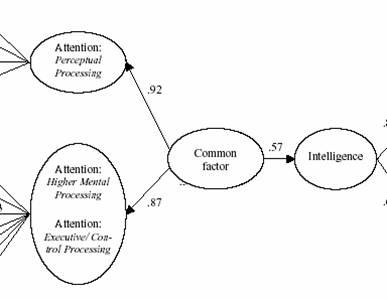
The following article is "in press" in the journal Intelligence and provides some interesting insights into the structure of the construct of attention and the relations between attention constructs and general intelligence.
The article introduction provides a nice scheme for organizing the different attentional constructs that have emerged from different research traditions. I have included the relevant excerpts below the abstract.
The best fitting model, which suggested that attention may be a higher-order construct that subsumes two lower-order attentional constructs, is displayed in the figure above.
One usual caveat...this study was conducted with high school and college students...generalizability to younger populations is not known.
Schweizer, K., Moosbrugger, H. & Goldhammer, F. (in press). The structure of the relationship between attention and intelligence, Intelligence.
Abstract
- The relationship between attention and general intelligence was investigated considering the different types of attention: alertness, sustained attention, focused attention, attentional switching, divided attention, attention according to the supervisory attentional system, attention as inhibition, spatial attention, attention as planning, interference, attention as arousal, and attention according to the assessment tradition. In a sample of 197 participants the relationship of attention and intelligence was investigated by means of structural equation modeling. The results revealed that each type of attention was substantially related to intelligence on the latent level. Furthermore, a high degree of overlap in predicting intelligence was observed for the various types of attention. Comprehensive models based on resources theory and Posner’s dimensions were also investigated. The best model of the relationship between attention and intelligence included two first-order and one second-order latent variables of attention and one of intelligence. It predicted 32% of the variance of intelligence.
Sources of research on attention:
- Perceptual attention effects research. In this field the following types of attention are considered: alertness, sustained attention which is assumed to include vigilance, focused attention, spatial and selective attention/attentional switching and divided attention (Coull, 1998; Sturm & Zimmermann, 2000; Zomeren & Brouwer, 1994). For ease in communication, spatial and selective attention/attentional switching is addressed as attentional switching.
- Working memory and attention research: The research concerning working memory provides another source since the central executive of working memory is associated with a supervisory attentional system (Baddeley, 1986). This system is necessary in order to guarantee appropriate behavior in situations that are demanding since they do not enable the rapid execution of automatic processes. The corresponding type is denoted supervisory attention.
- Information processing attention research. Another source is given by a scheme that includes several types of attention referring to all the sections of information processing (Neumann, 1992, 1996). It includes inhibition of action, spatial attention, planning of action, skill-based interference and arousal as types.
- Assessment tradition research: Finally, there is the assessment tradition as source. It includes various measures, which represent this ability and are applied in professional psychology for selection purposes, especially in traffic psychology.
The best fitting model is summarized in the partial figure above (figure only displays the structural or latent factor relations). In terms of the attention construct, it suggests two general categories of attention. One represents the perceptual aspects of attention while the other represents characteristics of attention involved in higher-level cognitive/information processing (including working memory). Interested readers are encouraged to track down this manuscript when it is published for additional details.

No comments:
Post a Comment